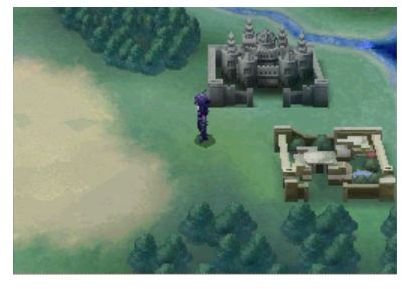Nintendo DS: A Game to learn Japanese: Final Fantasy IV
Lesson 4
If this your first time browsing this guide, I suggest you get started with the first lessons available here.
The Japanese version of Final Fantasy IV can be purchased online here.
In order to make some more progress in our learning, you will need to skip the introduction dialogue in Final Fantasy IV as Cecil is returning to Baron castle to return the Water crystal to the king. This is because at this point in time trying to understand so much dialogue would be a hurdle and would discourage just about anyone from learning the language.
Instead, we’ll slowly integrate easily digestible bits and pieces about the language until we’ve made enough progress to read and understand key elements in dialogues. This will allow us to understand the general idea of what is said without having to understand every single word which is written.
If this is your first time playing the game, suffice to say that Cecil feels remorse about taking a magical crystal from the village of Mysidia. After confronting his king about it, he is sent to deliver a package to a nearby village with his friend, Kain.
The Menu
After a short discussion with the key, you will be able to control Cecil (セシル). Before you start exploring however, open up the character menu as this is what we’ll study in this lesson.
In the menu, much like in the English version, you will see 9 different options displayed on the left.
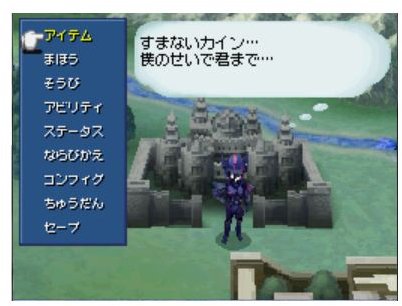
In the previous lessons, I mentioned that Katakana (the angular script) was used for words of foreign origins… Let us now see how this works.
Starting from the top, look at the first, fourth, fifth, seventh and ninth options. You’ll notice that they’re all written in Katakana.
Let’s focus on those words right now as they’re much easier to learn for English speakers than the words written in Hiragana (the other options in the menu).
Katakana: Words of Foreign Origin
Let’s look at the words we’ve selected from the menu:
アイテム
アビリティ
ステータス
コンフィグ
セーブ
Now compare each one of the katakana with the following chart:
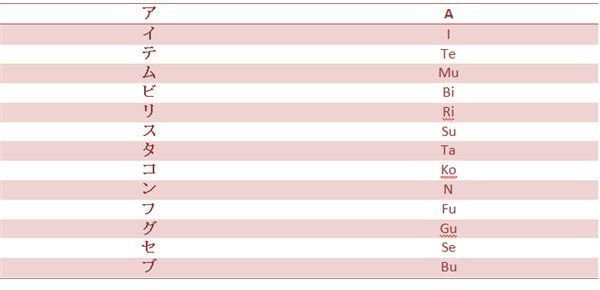
Let’s do the first one together: アイテム.
Read each katakana loudly and repeat the process a few times. This word sounds very, very similar to its English equivalent. Can you guess what it is?
…
The answer is: item (translated as ‘‘inventory’’ in the English version).
The good thing with words written in Katakana is that simply by reading them out loud you can often guess the actual meaning in English.
Exercise #4
Match each one of the words written in Katakana with their English equivalent. In order to do so, simply read each word in Katakana and compare the sounds with the English words.
Note: Some words in Katakana will not match the English in form but in meaning. For example, the word item is the equivalent of inventory.
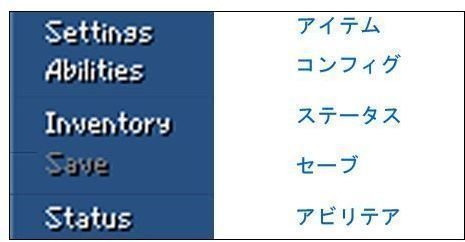
Exercise #4 Answers
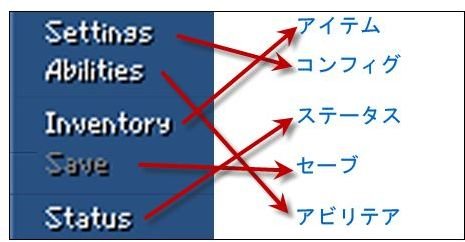
Lesson 5
In the previous lesson, we saw that Katakana sometimes referred to words of foreign origins just like “item” or “config”.
In this lesson, we’ll get more familiar with hiragana.
Words of Local Origin
As opposed to Katakana which is used for words from other countries, hiragana is most often used for words originating from Japan.
Confused? Let’s take another look at our menu and target the words written in hiragana.
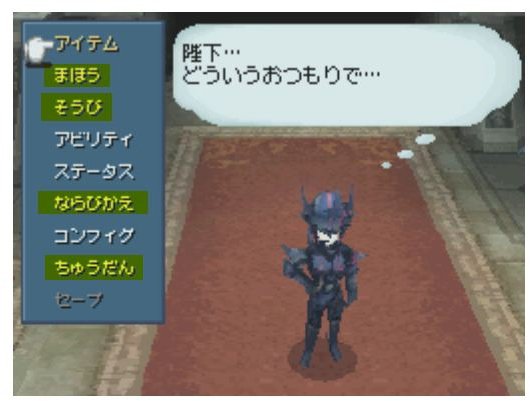
Let’s focus on the second word written in hiragana, そうび。Look at your hiragana chart and try to decipher そうび。
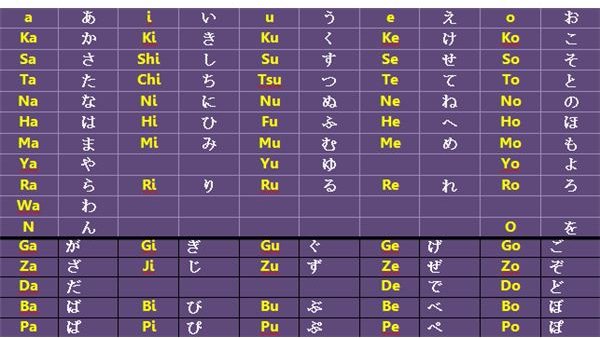
You should have something like this: “soubi”. It’s is pronounced similarly to “so be it” in English although you need to pronounce the “o” longer (sooo be).
Now, if you hear that sound, can you relate to anything you know in English? Probably not and this is because this word originates from Japan and has no link with English words.
Those words are much more difficult to learn as they their meaning cannot be guessed by saying them out loud (like words written in Katakana).
Translating the Words
Unfortunately, there really is not alternative to using a dictionary when trying to determine the meaning of a word of Japanese origin.
If you have the Internet, there are plenty of good Japanese-English dictionaries out there.
In order to get familiar with the resources available on the internet, let’s do a quick exercise.
Here are the four words from the menu we have yet to understand:
まほう
そうび
ならびかえ
ちゅうだん
Copy and paste each one of the words in the search function here.

Once you’ve pasted the word in the search box, press Enter. You will be given an English translation (or a few translations).
Exercise 5
Based on the translations you got, match the hiragana with their English counterpart (match the right letter with the correct English term).
Note: when looking at the translations, keep an open mind and don’t look for the specific English word. If the general English definition matches the English word you’re looking for, then it is the translation you are looking for.
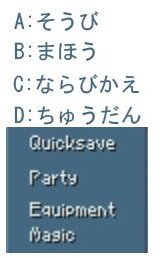
Answer Key: Exercise 5
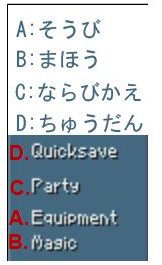
What’s Next?
Congratulations! You can now make sense of the whole menu, which is no small task.
In the next lesson, we’ll get familiar with a fundamental Japanese grammatical element: the grammatical particles!
Lesson 6
In this lesson, We’ll encounter our first grammatical particle. Sounds complex doesn’t? Well, it’s actually pretty simple to grasp once you understand how it works.
What Do Grammatical Particles Look Like?
As usual, let’s use an example to better understand the function of grammatical particles in Japanese.
Now that you have full control of セシル(Cecil), keep walking (or running) left until you get to two guards sitting next to a table. Have a look at the screen below to better orient yourself in case you’re having a hard time finding the guards.
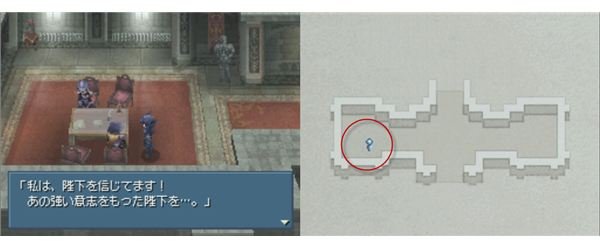
Go ahead and talk to the guard nearest to you (again, look at the screen if in doubt).
Let’s have a better look at the first sentence he says:

As you can see, there are four different Kanjis in this sentence (marked in green) and the rest is written in hiragana (marked in yellow).
Now the first thing you will need to know is that Japanese grammatical particles are ALWAYS written in Hiragana. This is very important to keep in mind!
Before explaining in greater detail how the particles work, allow me to filll you in about the various meanings of the words in this sentence:
私:me, I
陛下:highness (the king)
信:trust, believe
Now that any confusion about the vocabulary has been cleared up, let’s see how the particles actually work.
The Function of Grammatical Particles
What follows 信 serves as a complement similarly to a suffix in English. As of right now I won’t go into more details about this as we’ll cover this in our future lessons and our aim right now is to focus on the grammatical particles.
Knowing this, there are only two hiragana left which are grammatical particles: は and を**.**

Now grammatical particles give you, the reader, information about what precedes the actual particles.
The particles couldn’t be used on their own as they are merely used to give meaning to the sentence.
Although a few hiragana can have a quite a few different functions, we’ll focus on just two functions for now.
The particles couldn’t be used on their own as they are merely used to give meaning to the sentence.
Although a few hiragana can have a quite a few different functions, we’ll focus on just two functions for now.
は:indicates the topic of the sentence
を:indicates a direct object
What precedes は is 私 which means that the sentence will be about… the person who is talking to you (in this case, the guard).
What precedes をis 陛下 (highness), which means that the “highness” will be the direct object of what follows: “信じてます” (to trust).
Knowing this, can you figure out the English translation?
And the Answer is…
If you translated something among the lines of:
“As far as I’m concerned, I believe in the king”, you got it right.
Here’s the dialogue in English:
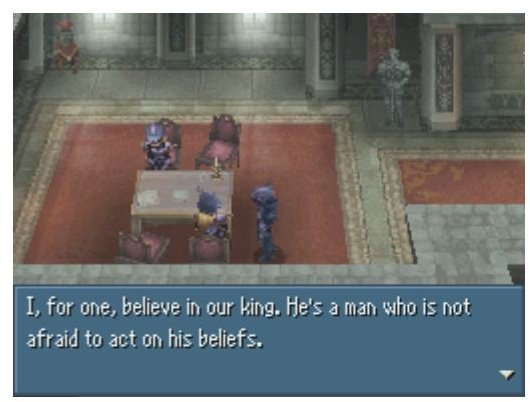
This post is part of the series: Learn Japanese by Playing Final Fantasy IV
Who said that learning a language had to be boring? This guide is meant to introduce the Japanese language step by step to beginners without any prior knowledge of the language, through playing Japanese games on the Nintendo DS.
